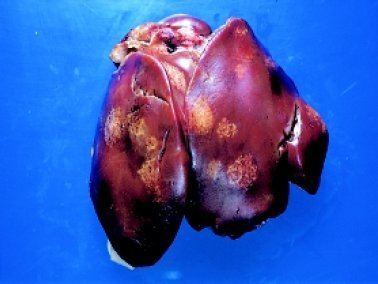 | ||
Histomoniasis (or histomonosis) is a disease of birds, particularly of chickens and turkeys, due to parasitic infection of a protozoan, Histomonas meleagridis. It is a form of blackhead disease in poultry. The parasite specifically infects the cecum and liver. Symptoms of the infection include depression, reduced appetite, poor growth, increased thirst, sulphur-yellow diarrhoea, listlessness, and dry, ruffled feathers. The head may become cyanotic (bluish in colour), hence the common name of the disease, blackhead; thus the name 'blackhead' is in all possibility a misnomer for discoloration. It is particularly highly fatal in poultry, and less in other birds. Currently, no prescription drug is available to treat this disease.
Contents
Etiology
A protozoan H. meleagridis is responsible for histomoniasis of gallinaceous birds ranging from chickens, turkeys, ducks, geese, grouse, guineafowl, partridges, pheasants, and quails. The protozoan parasite is transmitted through the eggs of a nematode, Heterakis gallinarum. The eggs are highly resistant to environmental conditions, and H. meleagridis is, in turn, highly viable inside the eggs, even for years. Birds are infected once they ingest the eggs of the nematode in soil, or sometimes through earthworms which had ingested the egg-contaminated soil. Outbreak can occur rapidly from the heavily infected bird in a flock readily through normal contact between uninfected and infected birds and their droppings in the total absence of cecal worms. For this reason, infection can spread very quickly. Once inside the digestive system of the host, the protozoan is moved to the cecum along with the eggs of H. gallinarum.
Histopathology and symptoms
Histomoniasis is characterized by blackhead in birds. H. meleagridis is released in the cecum where the eggs of the nematode undergo larval development. The parasite migrates to the mucosa and submucosa where they cause extensive and severe necrosis of the tissue. Necrosis is initiated by inflammation and gradual ulceration, causing thickening of the cecal wall. The lesions are sometimes exacerbated by other pathogens such as Escherichia coli and coccidia. Histomonads then gain entry into small veins of the blood stream from the cecal lesions and migrate to the liver, causing focal necrosis. Turkeys are noted to be most susceptible to the symptoms in terms of mortality, sometimes approaching 100% of a flock. Diagnosis can be easily performed by necropsy of the fresh or preserved carcass. Unusual lesions have been observed in other organs of turkey such as the bursa of Fabricius, lungs, and kidneys.
Symptoms appear within 7–12 days after infection and include depression, reduced appetite, poor growth, increased thirst, sulphur-yellow diarrhoea, listlessness, drooping wings, and unkempt feathers. Young birds have a more acute disease and die within a few days after signs appear. Older birds may be sick for some time and become emaciated before death. The symptoms are highly fatal to turkeys, but effect less damage in chickens. However, outbreaks in chickens may result in high morbidity, moderate mortality, and extensive culling, leading to overall poor flock performance. Concurrence of Salmonella typhmurium and E. coli was found to cause high mortality in broiler chickens.
Prevention and treatment
Currently, no therapeutic drugs are prescribed for the disease. Therefore, prevention is the sole mode of treatment. Deworming of birds with anthelmintics can reduce exposure to the cecal nematodes that carry the protozoan. Good management of the farm, including immediate quarantine of infected birds and sanitation, is the main useful strategy for controlling the spread of the parasitic contamination. The only drug used for the control (prophylaxis) in the United States is nitarsone at 0.01875% of feed until 5 days before marketing. Natustat and nitarsone were shown to be effective therapeutic drugs. Nifurtimox, a compound with known antiprotozoal activity, was demonstrated to be significantly effective at 300–400 ppm, and well tolerated by turkeys.
